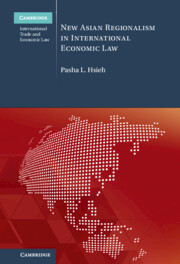Book contents
- New Asian Regionalism in International Economic Law
- Cambridge International Trade and Economic Law
- New Asian Regionalism in International Economic Law
- Copyright page
- Contents
- Figures
- Tables
- Preface
- Abbreviations
- 1 Introduction: New Asian Regionalism As a Global Paradigm Shift
- 2 The Legalization of the ASEAN Economic Community
- 3 Signing the RCEP As a Milestone
- 4 Constructing Interregionalism: The New EU Strategy to Asia
- 5 Revitalizing the US Pivot to Asia
- 6 The Marginalization or Rejuvenation of APEC?
- 7 Conclusion
- Select Bibliography
- Index
2 - The Legalization of the ASEAN Economic Community
Published online by Cambridge University Press: 03 December 2021
- New Asian Regionalism in International Economic Law
- Cambridge International Trade and Economic Law
- New Asian Regionalism in International Economic Law
- Copyright page
- Contents
- Figures
- Tables
- Preface
- Abbreviations
- 1 Introduction: New Asian Regionalism As a Global Paradigm Shift
- 2 The Legalization of the ASEAN Economic Community
- 3 Signing the RCEP As a Milestone
- 4 Constructing Interregionalism: The New EU Strategy to Asia
- 5 Revitalizing the US Pivot to Asia
- 6 The Marginalization or Rejuvenation of APEC?
- 7 Conclusion
- Select Bibliography
- Index
Summary
The chapter explores the legalization of the ASEAN Economic Community. It offers insight into the major characteristics of the new AEC Blueprint 2025 and the changing nature of the ASEAN way that have collectively shaped Asian integration. Furthermore, it analyzes ASEAN’s evolving legal framework that governs trade in goods, trade in services, investment protection and liberalization and dispute settlement. Emerging areas such as banking services, electronic commerce (e-commerce) and development assistance will also be discussed. Importantly, ASEAN’s economic integration trajectory is distinct from the neoliberal approach premised on the Washington Consensus. The chapter explains why and how the ASEAN approach guided by pragmatic incrementalism could benefit the development of the Global South. Finally, the chapter examines the externalization of the ASEAN way under ASEAN’s external agreements that underpin the regional economic architecture.
- Type
- Chapter
- Information
- New Asian Regionalism in International Economic Law , pp. 29 - 66Publisher: Cambridge University PressPrint publication year: 2021

